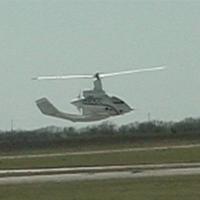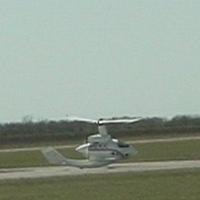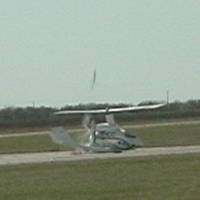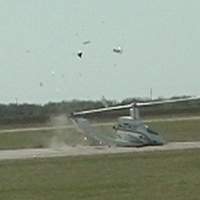There Are Those Who Have, and Those Who Will
 "They just forgot to put the gear down," was the
simple answer to the expensive and temporarily painful question of
"what happened?" to the Carter Copter last week.
"They just forgot to put the gear down," was the
simple answer to the expensive and temporarily painful question of
"what happened?" to the Carter Copter last week.
As always, Jay Carter was open to our questions. He explained
that a lot of enthusiasm, and some high-pressure mistakes, can
often spell the difference between 'straight' and 'busted.' The
Army Aviation Association was meeting in Ft Worth (TX) last week,
and, as Jay explained it, "There's a lot of interest in our
machine... in fact, they were there to see us fly." With the V-22
Osprey always a question mark, and with the 20-year gestation of
that iffy machine still moving slowly, Carter said the assembled
brass was enthusiastic. "One of the colonels told us, after
witnessing the test flight, that this was, 'the most impressive
demonstration [he] had ever seen.'" (One of our friends at the
factory said we'd have to confirm with Jay, but added, "I
think we impressed them.")
What happened? No, really...
Jay explained, "The pilots just forgot to lower the landing
gear." These guys are top test pilots, though. What else? "All the
flights in this test cycle had been with the gear extended. This
was the second time in seven months they retracted the gear." It
was mostly for show, this time, even though a lot of data are
collected on every flight. Carter continued, "They were coming down
with almost no thrust -- showing the capabilities of how quiet, how
slow we can descend, in autorotation. They were planning on making
an 'aggressive' landing."
They were on-plan, all right: "They hit pretty hard -- they had
tried to power out of it -- they hit so hard the tailbooms
deflected so far, that the prop hit the ground." It wasn't a
'crash,' except that there was no landing gear to absorb the
impact. "Ten fps descent wouldn't have done anything to the landing
gear," Carter assured us.
One thing led to another...
"When the first blade came off," Carter noted, "it [the
rotational mass] was severely out of balance. In the
half-revolution before the second blade came off, [the remaining
blade] did some bad damage."
So much screaming, so little time...
"We were screaming at them on the radios, 'gear up!' but there
was so much noise, they didn't know what we were saying, until too
late." It was a case of too much information, during an
already-stressful phase of the flight.
Damage assessment:
The fuselage and booms are badly damaged; the prop is wrecked;
the engine is parts. On the 'good' side, the main rotor is OK, the
wings are fine; the gear was well-protected; and most of the
instrumentation and controls are salvageable. Getting it home
wasn't too much of a problem. Our factory friend said, "It's
rolling on the wheels it went there with -- we just lifted it up,
put the wheels down, and rolled it on the trailer."

How did it happen?
Mr Carter explained, "We have a gear horn, and we disabled it
last week." More explanation was in order: "A lot of our testing
was taxiing. Every time we got over 50 mph, the alarm would go off,
and freeze the display: 'Lower Landing Gear!' They wanted to make
'flying' takeoffs, and that alarm was annoying. The pilots said it
was annoying," Jay said, "so I disabled it." He laughed, wryly,
"They promised me, they wouldn't forget!" In retrospect,
that still wasn't the best idea. "I should have redesigned it, so
it wouldn't give that nuisance alarm..."
Everything else was going so well, too.
Jay reverted to his usual, wonderful 'optimist' mode: "We just
finished some really neat tests-- our boosted controls worked
great. We lost boost pressure one time, and the pilots merely said,
'It's stiff, but flyable.' That's a great confidence builder, that
they could lose boost and still be flyable." The systems are
proving capable, too: "One test flight -- 19 minutes long -- for 18
minutes of that, it was on total automatic controls. We did a lot
of nice things, and we gave them one heck of a demonstration," Jay
noted. Even though it didn't have the ending he wanted, he pointed
out that the basic design is strong as dirt: "There's a lot that
could happen, and they did not get hurt."
Schedule will slip a few months.
Carter was in the cusp of the next phase of prototyping, and had
lined up some showcases for what will soon be the world's fastest
rotorcraft. "We were going to demonstrate for more military, for
the SATS meeting the first of May; and people from Europe, who
wanted to have another look. We're three months behind."
 Nevertheless, he's already planned the
improvements he wants: "We're going to put in out new turbocharged
engine, and a few changes to the gear, and a few changes to the
automatic controls. We'll make it more-reliable, with a little more
performance." He's going to blow the engine, too: "We need more
horsepower -- 300 now, with a 3750-pound aircraft -- that's not
very much [power to weight], even for a fixed-wing aircraft. [The
low power shows] we've got a very efficient aircraft -- even this
way, we can climb 550 fpm -- at 12.5 lb/hp. That's all we do in our
family's old Mooney, with four of us aboard."
Nevertheless, he's already planned the
improvements he wants: "We're going to put in out new turbocharged
engine, and a few changes to the gear, and a few changes to the
automatic controls. We'll make it more-reliable, with a little more
performance." He's going to blow the engine, too: "We need more
horsepower -- 300 now, with a 3750-pound aircraft -- that's not
very much [power to weight], even for a fixed-wing aircraft. [The
low power shows] we've got a very efficient aircraft -- even this
way, we can climb 550 fpm -- at 12.5 lb/hp. That's all we do in our
family's old Mooney, with four of us aboard."
Next?
Jay took the setback/opportunity in stride: "We've had worse;
we've had better. Basically, I learned what I needed to learn, and
we needed to make some changes, and with all the demonstrations we
were having to fly, we never would have made them. Now, we'll get
that turbocharged engine in, and we'll have excess horsepower."
That'll be neat.
They'll see you at Oshkosh.
 ANN's Daily Aero-Linx (04.16.24)
ANN's Daily Aero-Linx (04.16.24) Aero-News: Quote of the Day (04.16.24)
Aero-News: Quote of the Day (04.16.24) Airborne 04.10.24: SnF24!, A50 Heritage Reveal, HeliCycle!, Montaer MC-01
Airborne 04.10.24: SnF24!, A50 Heritage Reveal, HeliCycle!, Montaer MC-01 Airborne 04.12.24: SnF24!, G100UL Is Here, Holy Micro, Plane Tags
Airborne 04.12.24: SnF24!, G100UL Is Here, Holy Micro, Plane Tags Airborne-Flight Training 04.17.24: Feds Need Controllers, Spirit Delay, Redbird
Airborne-Flight Training 04.17.24: Feds Need Controllers, Spirit Delay, Redbird









